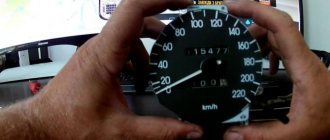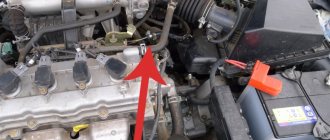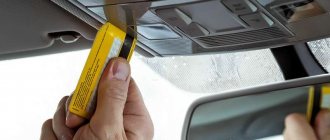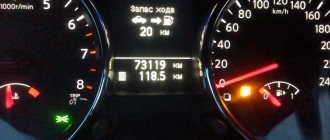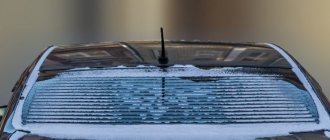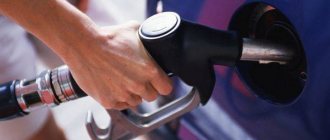A sudden, persistent smell of gasoline in the car's interior is most often a sign of a malfunction in the fuel system. This problem can be fatal under certain circumstances, and therefore it must be found and eliminated immediately. By the way, gasoline is dangerous not only because it burns well and quickly, leaving only a charred body of the car. Its vapors are also harmful, regular inhalation of which can cause dizziness, nausea, hallucinations and loss of consciousness. And an unconscious driver is a dead driver.
The car smells like gasoline after refueling.
Let's start with, perhaps, banal, but not for all obvious reasons. The first situation was when you smelled gasoline in the car after visiting a gas station where there was no gas station attendant. That is, you filled the tank with fuel yourself. In such a case, it is advisable to have some disposable gloves in the trunk so that you do not have to take the “gun” with your bare hands. Of course, no one monitors its sterility. Therefore, it is quite logical that after refueling yourself, your hands will stink of gasoline for a long time.
The second situation - there was a gas station attendant, but the circumstances were such that, in addition to the neck of the tank, gasoline also got onto its “surroundings” - on the hatch, lid, body... In such cases, even if you did not touch all of the above, the smell of gasoline may leak into the car interior through open windows.
Both situations are as banal as they are harmless. You can wash your hands, and drops and smudges of gasoline in the area of the filler neck will quickly evaporate, and will not bother you with an unpleasant odor in the cabin for a long time.
How to remove smell from the interior?
It is difficult to get rid of the unpleasant smell of fuel in the cabin. However, there are several effective methods, which will be discussed below.
Flavors
How to remove the smell of gasoline in a car for a long time? To make your car always smell nice, you can use fragrances. They come in different scents. It all depends on your preferences. They also help neutralize gasoline aroma. The main thing is not to use several scents at the same time.
Interior dry cleaning
The most effective method is dry cleaning. However, this is an expensive procedure. First, the interior needs to be vacuumed and then treated with a special solution. He will clean and disinfect the car. Afterwards, a special foam is applied and the fabric upholstery is dried.
Ozone interior cleaning
The essence of the method is to use a generator containing ozone molecules inside. They effectively remove unpleasant odors. The main advantage of ozone cleaning is the destruction of mold and bacteria. After the procedure, a pleasant smell will linger in the salon for a long time.
Shampoo wash
- Some motorists wash the interior with car shampoo.
- The product is applied to the upholstery, cleaned with a brush, and washed off with water.
- If necessary, repeat the procedure.
Soda
- First, sprinkle baking soda on the gasoline stains.
- The product must be left for 24 hours.
- Afterwards, vacuum the interior.
- Within a day the unpleasant smell will disappear.
Vinegar
This substance helps cope with unpleasant odors. Prepare a vinegar solution (1 liter of vinegar per 2 liters of water) and spray the product throughout the cabin. A spray bottle or spray bottle will help. Afterwards you need to check the car within 3-4 hours.
Coffee
An effective way to get rid of unpleasant odors in your car is to use ground coffee. Add 1 tbsp. l. on the gasoline stain and leave for 2-5 hours. Coffee contains oils that neutralize unpleasant odors.
Dishwashing liquid
If there are gasoline stains on the rugs or upholstery, you can remove them with liquid dish soap. It contains components that break down fats. Such products have a pronounced pleasant aroma that will fill the entire salon. Apply the liquid to the stain, leave until completely absorbed, and rinse with water.
Ventilation
- An effective way to eliminate unpleasant odors is ventilation.
- For safety reasons, this should be done in a garage or private yard.
- Leave the doors, trunk and hood open for several hours, or better yet, for a day.
- If there is a problem with the gas tank or its components, then this method will not help. First you need to fix the damage.
As you can see, there are many reasons for the smell of gasoline in the cabin. First you need to eliminate the cause, and then remove the smell of gasoline from the cabin.
Leaks under the hood
Gasoline leaks under the hood are already a dangerous breakdown, and until it is found and fixed, it is better not to start the engine at all. Who knows how much fuel spilled there, and where it ended up after that. A “light” that can “light” highly flammable gasoline vapors under the hood can be found at the generator, at the starter, and at the exhaust manifold.
As a rule, if the car is relatively new, the entire engine compartment fuel system is visible. To look for leaks, carefully inspect the lines and fuel filter. Gasoline especially “likes” to leak at the junctions of the pipes and fittings.
Attention! It is likely that with the engine turned off (the gasoline pump not working), you will not see any obvious leakage. Perhaps it manifests itself when pressure is created in the lines. If you suspect this reason, it is better to contact a professional. As a last resort (if your hands are itchy or there is no fear), start the engine for a short period of time and do not forget to re-read the same highlighted block above. As a rule, if there is a leak under pressure, it will quickly manifest itself. Immediately turn off the engine and only then eliminate the “weak link”.
In modern cars, finding fuel leaks under the hood is a little more difficult. At the very least, to do this you will have to remove the decorative cover and, perhaps, arm yourself with a good flashlight. While you are looking for a leak, take a sniff. Gasoline is such an infection - it gives itself away with its smell quite easily.
Under-hood problems also include fuel injectors, but more on them a little later.
How to diagnose a problem
Depending on the car model, fuel leak problems will vary. Let's look at this using the example of injection and carburetor engines.
Diagnostics of carburetor machines should be carried out with the engine running. If you check the car at idle speed, the carburetor may not allow fuel to pass through. However, when you press the gas, the pressure in the system increases significantly, which leads to a leak under the membrane. The cause may be poor bolt fastening or loose tightening.
Important! When diagnosing injection machines, you need to pay attention to the operation of the injectors. It is their malfunctions (breakage, clogging or defects) that often lead to leakage of the fuel mixture.
Depressurization of the fuel tank
If you ask experienced car repairers, they will tell you that in 95% of cases the cause of the smell of gasoline in the cabin is the fuel tank. This is not strange, since this is where the most gasoline is constantly found. Finding a gas tank leak is not an easy task. “Good” if it turns out that fuel has begun to leak somewhere in the visible part. This problem is easy to find, although not very easy, but eliminated.
It’s a completely different matter when the “dog is buried” somewhere between the tank and the body of the car. In this place, the container is pressed tightly against the machine and, according to the manufacturers’ idea, should be motionless. To prevent metal from rubbing against metal, the tank and body are separated by gaskets made of a material that tends to deteriorate over the years. When such a moment comes, it is no wonder that a literal hole appears in the tank. This is where the cabin can smell of gasoline.
Attention! If you suspect that the gas tank is leaking, you should be careful when dismantling it. Due to the fact that this part is located, to put it mildly, where it is “damp,” the fastening elements turn out to be completely rusted. They are often cut down with a grinder, which can “light” the gasoline vapors so that mom doesn’t worry.
Why does your car smell like gasoline when it’s cold or when it’s hot?
It should be kept in mind: if gasoline vapors enter the cabin after starting the injector, this is not always a sign of a breakdown. An unpleasant odor appears after a so-called cold start in winter and gradually disappears as the engine warms up. If you observe something like this, you can assume that:
- The ECU reads information coming from a temperature sensor, which is located directly inside the motor: it signals the low temperature of the unit;
- taking the received information as a basis, the control unit issues a command to significantly enrich the fuel, and this significantly increases the speed;
- When operating on a rich mixture, fuel entering cold engine cylinders does not burn completely.
In this case, the smell that the driver feels comes from the exhaust pipe. Warming up the engine will allow you to use fuel more efficiently, and after 2-3 minutes the smell will disappear. For most cars, this situation is considered normal.
But in some cases it is still necessary to talk about a breakdown, especially if we are talking about modern cars that were developed according to Euro-4 or higher standards. Partial combustion of gasoline occurs not only due to over-enrichment of the fuel, which is necessary to ensure stable operation during a cold start; other reasons are also possible.
We recommend
“The car smells like burnt rubber: 3 possible reasons” Read more
Possible malfunctions in the car - problems with the ignition system, problems with compression in the cylinders and a dozen other problems - can lead to incomplete combustion of the mixture. In such cases, significant excess fuel consumption is common. Added to this is the fact that the engine is running rough, begins to lose power greatly, and in some cases it may start to smoke.
Simply put, if the smell of gasoline appears during operation, then this is a direct indication that the fuel is not being burned completely. In this case, an in-depth diagnosis is carried out at a service station. The technicians check the spark plugs and ignition coil, wires and other important elements.
Don't forget to check the ECM sensor (also called the oxygen sensor). When diagnosing it, the current condition of the air filter is assessed and the condition of the injection nozzles is analyzed. It is also worth checking the tightness of the system for airing.
Failure to seal the injectors is often the cause of the smell of gasoline on injection engines. In this case, the tightness is restored through the use of new o-rings - they are dense rubber products that can become unusable over time.
Fuel filler neck and cap
The filler neck in most cars is a separate part that is attached to the gas tank either with a weld or a flexible hose and clamps. During long-term use of the car, this place gradually becomes looser, and a leak may appear here. It is difficult to diagnose such a breakdown, since access for visual inspection is usually limited.
The leak itself, as such, at the junction of the gas tank and the neck may not be noticed. And all because she is not there. The ubiquitous gasoline fumes can stink. Most often, with such an “illness,” the smell intensifies (or appears only briefly) immediately after a generous dressing. There is more gasoline in the tank, and it immediately displaces the vapors that have accumulated there through a leaky connection to the neck.
The gas tank cap is not the last place to look for the source of an intoxicating odor. This part is equipped with a sealing gasket, which, like everything else in the machine, is not made from durable materials. When it rots, gets lost, breaks, and so on, the smell of gasoline doesn’t take long to appear.
Many novice car owners mistakenly believe that there is a small hole in the gas tank cap, which is designed to relieve excess pressure. Gasoline in a tank can indeed expand significantly in the summer, as can its vapor. But the vapors do not escape through any hole in the lid (due to its absence there). And all because for these purposes brilliant car makers invented...
Absorber and company...
The absorber is a whole structure, which is designed to prevent expanding fuel and its vapors from inflating or rupturing the gas tank. But environmentalists and other “greens” do not allow gasoline vapors to be released into the atmosphere just like that. They “forced” the designers to introduce things into cars that could purify gasoline vapors and not cause irreparable harm to the environment.
The structure of the classic absorber is very simple. This is a plastic or metal box, inside of which there is a carbon (usually) filler that acts as a filter. Gasoline vapor from the tank enters here through a tube that fits onto the fittings.
The absorber can become the “culprit” of the smell in the car interior for several reasons:
- the carbon filter has already served its purpose;
- there is a leak at the hose connection points;
- for some reason the branch pipe of the ventilation branch has become bent and no longer allows vapor to pass through it;
- blockage in the gas tank ventilation system.
This problem is quite easy to diagnose and fix. It is quite possible to do without specialists. You should look for the absorber somewhere in the lower rear part of the car near the gas tank itself. In some cars it is “hidden” under the wing. The part is dismantled, cleaned, washed, checked for leaks and reinstalled. If after dismantling it becomes obvious that it will not work, replace it.
Inattentive gas station worker
Another reason is that the gas station worker does his job poorly, and drops of gasoline fall on the rear wheel of your car and on the body. If it's one or two drops, there shouldn't be any problems. But if the entire wheel is flooded with fuel, rear seat passengers will complain. They will likely smell a strong odor until the gasoline has completely evaporated.
What you can do is visit your nearest car wash and wash your rear wheel using effective shampoos. Or simply pour a large amount of water onto the wheel.
Fuel level sensor in the tank and fuel pump
It is a float connected to a banal ohmmeter. When there is more gasoline in the tank, the float rises, the resistance of the ohmmeter decreases, and the arrow on the instrument panel gives the owner an incomparable feeling of joy.
So, this sensor is attached directly to the gas tank and is sealed with a gasket. In some cars, the fuel level sensor is integrated into the tank in a single module with the fuel pump. One way or another, if the part is poorly secured or installed on a bad gasket, the smell of gasoline in the cabin cannot be avoided.
Problems with EVAP
The last reason that came to our mind is the EVAP system. A harmful gas emission control system is installed in many modern cars. One part of this system is a canister with a carbon filter. If it cracks, fuel will leak out of the car and give off an unpleasant odor.
The EVAP system can be located in different parts of the car, so it is better to check the location in the instructions or on forums on the Internet. A cracked canister should be replaced as soon as possible, as leaks can lead to fires and explosions.
Unsuccessful fuel system repair
Many “would-be masters” try to fix the fuel system using sealant, epoxy resin, cold welding and other “plasticine”. Oh yes, sometimes various “superglues” are used. Remember once and for all: gasoline is an excellent solvent, and sooner or later it destroys all these putties. If the fuel system was repaired with the help of these “plantains”, if you smell gasoline in the cabin, first of all, inspect the places of such “repairs”. Unfortunately, even professional craftsmen at decent service stations do not hesitate to use them.
Faulty catalyst
The task of the catalytic converter is to burn off the fuel vapor remaining in the exhaust gases. To do this, it must heat up to operating temperature, which on average ranges from 600 to 800 degrees. This takes time. Therefore, in the first minutes after starting the engine, the catalyst is simply not able to clean the exhaust. In this case, a slight smell of gasoline is normal.
If this is observed with a heated catalyst, it is necessary to check its condition. In case of burnout, the element will have to be replaced with a new one.
By the way, many drivers get rid of catalysts altogether.
Junk in the luggage compartment
We started with a triviality that was not obvious to everyone, and we’ll end with it. If nothing helps get rid of the persistent smell of gasoline in the car, look carefully in the luggage compartment. Perhaps there is a canister or bottle of fuel lying around, a rag that you use to wipe parts washed in gasoline, and so on. For an avid fan of turning nuts with his own hands, even his wrenches are “throughly soaked” in gasoline...
In addition to the smell of gasoline, there may be other foreign odors in the car interior, for example, a musty smell, the smell of mold or rot.
What car owners say about why their car smells like gasoline
- Location of the problem “You need to pay attention to the seals on the injectors in the injection engine. My fuel pressure regulator was leaking. Therefore, I closed two contacts on the diagnostic connector: turn on the ignition, and the pump starts working. While it’s working, you need to use a flashlight on the injectors to carefully look at where it’s leaking.”
- It doesn’t always leak
“I also had a strong smell, but I couldn’t figure out where it was leaking. And then they recommended that I remove the seat and see if everything is sealed. As it turned out, you just needed to insert the return hose all the way, and that’s it. Because of the small gap there was a terrible smell and it seemed like there was literally a fountain gushing somewhere.” - Need to check repair areas
“I also had a strong smell of gasoline in the car. A quick inspection did not find the cause. Upon closer inspection, I saw how little gasoline was seeping out at the base of the fuel pump fitting, which three years ago was broken off when changing the fuel filter and sealed with epoxy glue. During exposure to it, the glue became brittle and brittle, began to crumble and did not provide 100% tightness. As a result, I had to re-glue the fitting again.”We recommend
“What additives are added to gasoline: detailed information, the best compositions” Read more
- Checking the Hoses
“You need to carefully inspect the hoses at the fuel connections. This also happened when the hose was not pulled onto the fitting and the clamp did not secure it properly. You just need to feel all the connections with a dry hand while the engine is running - somewhere there will be an incomplete seal.” - Sometimes you can fix it
“I had a persistent smell of gasoline due to soggy rubber seals. When I was changing it, drops of gasoline got in and it began to deform. I barely got the O-ring in. But then it started to stink when the tank was full, and all I had to do was cut the sealing rubber at an angle and shorten it to size.”


